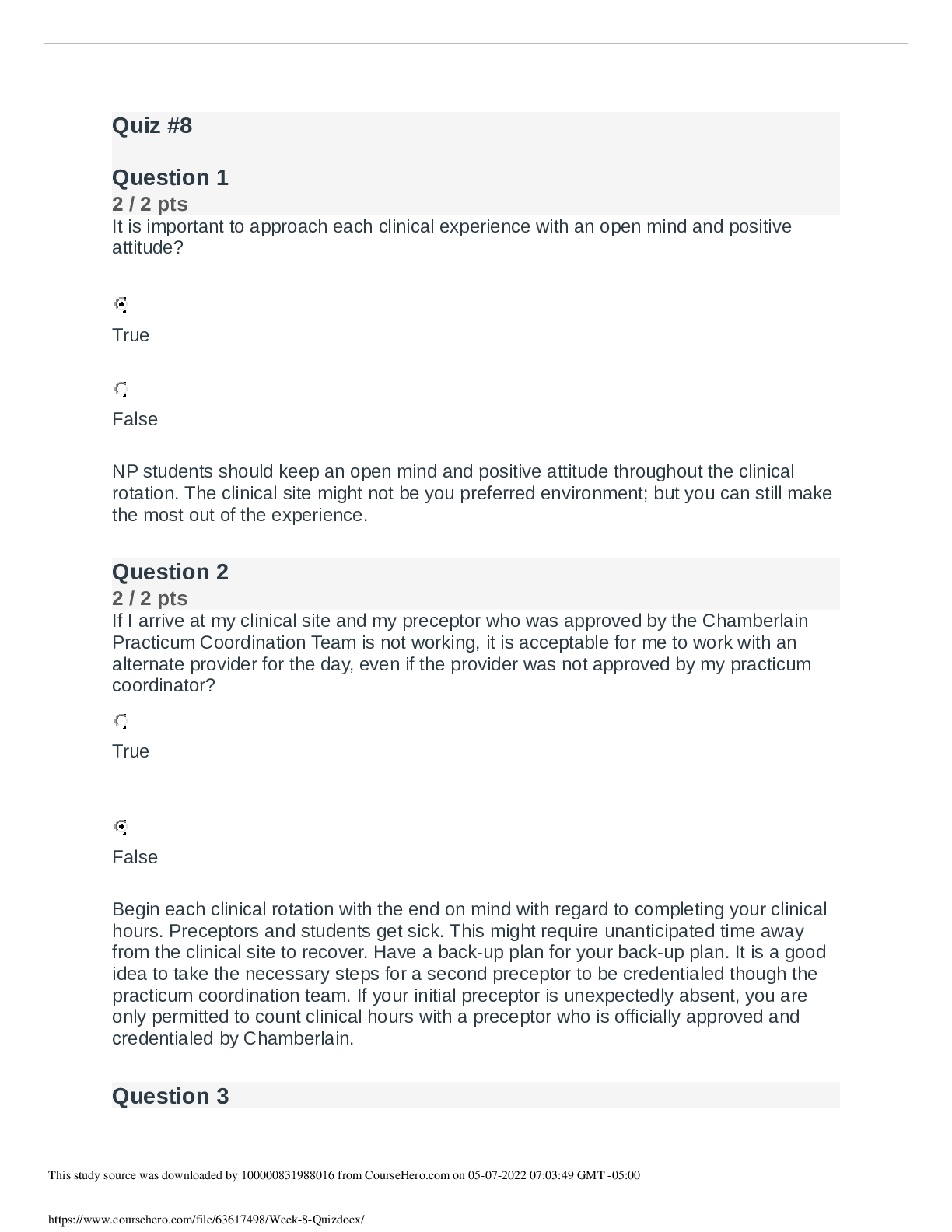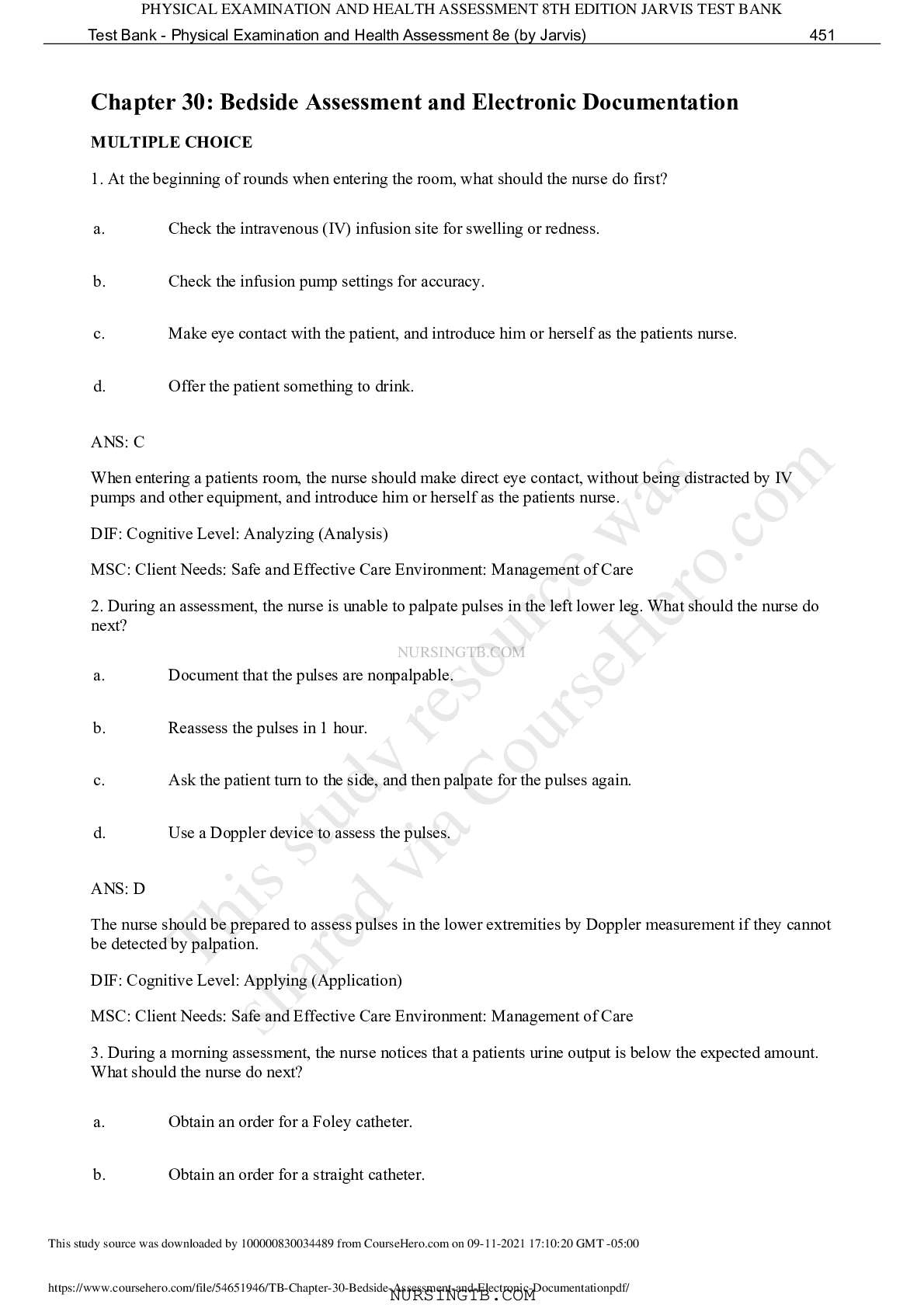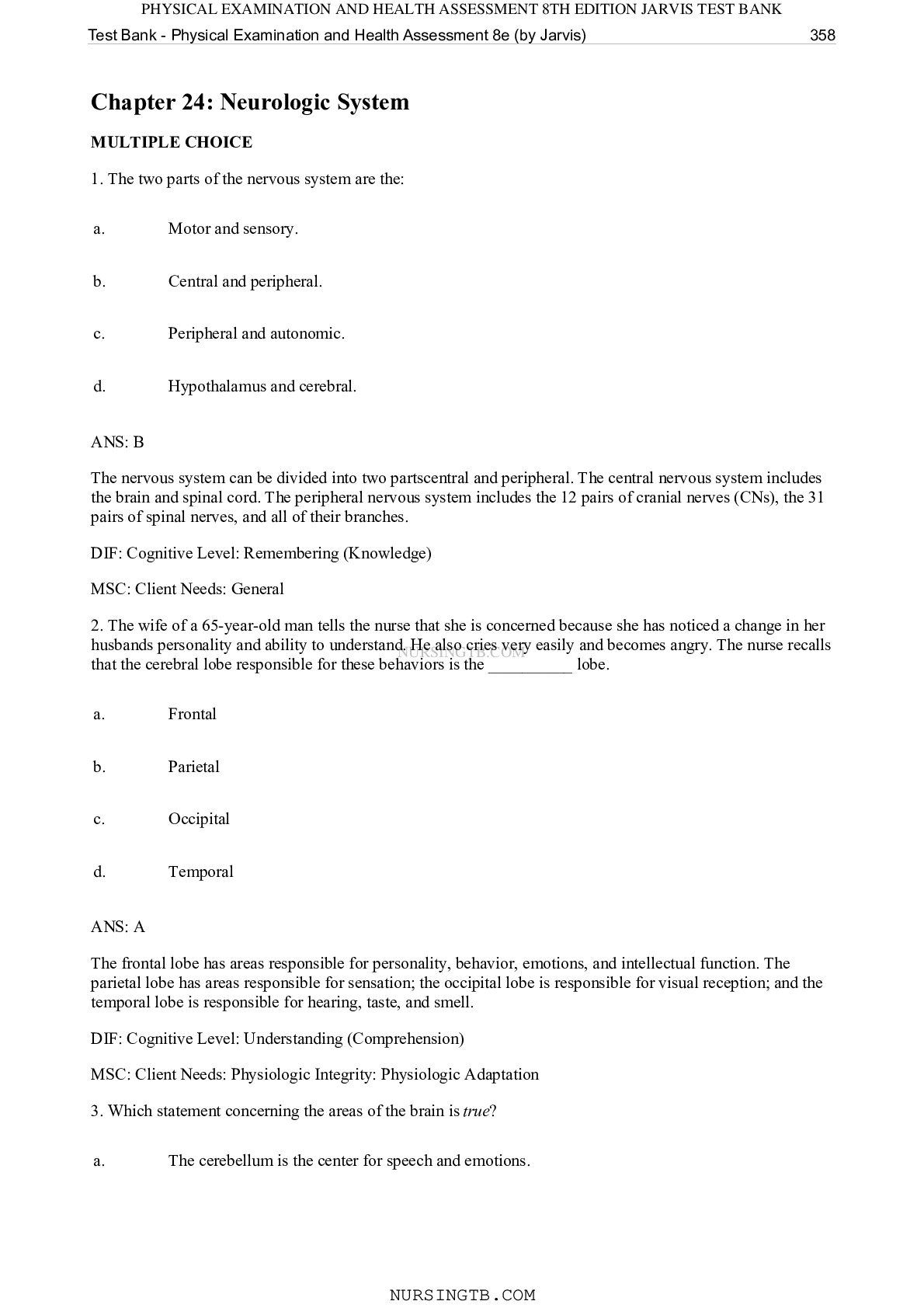*NURSING > QUESTIONS & ANSWERS > SOLVED!!! NR 509 COMPREHENSIVE REVIEW OF JARVIS 7TH EDITION CHAPTER 12 QUESTIONS (All)
SOLVED!!! NR 509 COMPREHENSIVE REVIEW OF JARVIS 7TH EDITION CHAPTER 12 QUESTIONS
Document Content and Description Below
SOLVED!!! NR 509 COMPREHENSIVE REVIEW OF JARVIS 7TH EDITION CHAPTER 12 QUESTIONS (Skin, Hair & Nails: Physical Examination & Health Assessment) ◇This material contains comprehensive summary of infor... mation in the form of great test questions with descriptive answers helpful for exams study. Thorough Review of Jarvis 7th Edition Chapter 12 Questions. All the best Champions! ______ MULTIPLE CHOICE 1. The nurse educator is preparing an education module for the nursing staff on the epidermal layer of skin. Which of these statements would be included in the module? The epidermis is: a. Highly vascular. b. Thick and tough. c. Thin and nonstratified. d. Replaced every 4 weeks. ANS: D The epidermis is thin yet tough, replaced every 4 weeks, avascular, and stratified into several zones. DIF: Cognitive Level: Understanding (Comprehension) REF: p. 199 MSC: Client Needs: General 2. The nurse educator is preparing an education module for the nursing staff on the dermis layer of skin. Which of these statements would be included in the module? The dermis: a. Contains mostly fat cells. b. Consists mostly of keratin. c. Is replaced every 4 weeks. d. Contains sensory receptors. ANS: D The dermis consists mostly of collagen, has resilient elastic tissue that allows the skin to stretch, and contains nerves, sensory receptors, blood vessels, and lymphatic vessels. It is not replaced every 4 weeks. DIF: Cognitive Level: Understanding (Comprehension) MSC: Client Needs: General REF: p. 200 3. The nurse is examining a patient who tells the nurse, “I sure sweat a lot, especially on my face and feet but it doesn’t have an odor.” The nurse knows that this condition could be related to: a. Eccrine glands. b. Apocrine glands. c. Disorder of the stratum corneum. d. Disorder of the stratum germinativum. ANS: A The eccrine glands are coiled tubules that directly open onto the skin surface and produce a dilute saline solution called sweat. Apocrine glands are primarily located in the axillae, anogenital area, nipples, and naval area and mix with bacterial flora to produce the characteristic musky body odor. The patient’s statement is not related to disorders of the stratum corneum or the stratum germinativum. DIF: Cognitive Level: Applying (Application) REF: p. 200 MSC: Client Needs: Physiologic Integrity: Physiologic Adaptation4. A newborn infant is in the clinic for a well-baby checkup. The nurse observes the infant for the possibility of fluid loss because of which of these factors? Subcutaneous fat deposits are high in the newborn. a. b. Sebaceous glands are overproductive in the newborn. c. The newborn’s skin is more permeable than that of the adult. d. The amount of vernix caseosa dramatically rises in the newborn. ANS: C The newborn’s skin is thin, smooth, and elastic and is relatively more permeable than that of the adult; consequently, the infant is at greater risk for fluid loss. The subcutaneous layer in the infant is inefficient, not thick, and the sebaceous glands are present but decrease in size and production. Vernix caseosa is not produced after birth. DIF: Cognitive Level: Applying (Application) MSC: Client Needs: Health Promotion and Maintenance 5. The nurse is bathing an 80-year-old man and notices that his skin is wrinkled, thin, lax, and dry. This finding would be related to which factor in the older adult? Increased vascularity of the skin a. b. Increased numbers of sweat and sebaceous glands c. An increase in elastin and a decrease in subcutaneous fat d. An increased loss of elastin and a decrease in subcutaneous fat ANS: D An accumulation of factors place the aging person at risk for skin disease and breakdown: the thinning of the skin, a decrease in vascularity and nutrients, the loss of protective cushioning of the subcutaneous layer, a lifetime of environmental trauma to skin, the social changes of aging, a increasingly sedentary lifestyle, and the chance of immobility. DIF: Cognitive Level: Applying (Application) MSC: Client Needs: Health Promotion and Maintenance 6. During the aging process, the hair can look gray or white and begin to feel thin and fine. The nurse knows that this occurs because of a decrease in the number of functioning: a. Metrocytes. b. Fungacytes. c. Phagocytes. d. Melanocytes. ANS: D In the aging hair matrix, the number of functioning melanocytes decreases; as a result, the hair looks gray or white and feels thin and fine. The other options are not correct. DIF: Cognitive Level: Understanding (Comprehension) REF: p. 201 MSC: Client Needs: Health Promotion and Maintenance 7. During an examination, the nurse finds that a patient has excessive dryness of the skin. The best term to describe this condition is: a. Xerosis. b. Pruritus. c. Alopecia. d. Seborrhea. REF: p. 201 REF: p. 201ANS: A Xerosis is the term used to describe skin that is excessively dry. Pruritus refers to itching, alopecia refers to hair loss, and seborrhea refers to oily skin. DIF: Cognitive Level: Remembering (Knowledge) MSC: Client Needs: Health Promotion and Maintenance REF: p. 203 8. A 22-year-old woman comes to the clinic because of severe sunburn and states, “I was out in the sun for just a couple of minutes.” The nurse begins a medication review with her, paying special attention to which medication class? a. Nonsteroidal antiinflammatory drugs for pain b. Tetracyclines for acne c. Proton pump inhibitors for heartburn d. Thyroid replacement hormone for hypothyroidism ANS: B Drugs that may increase sunlight sensitivity and give a burn response include sulfonamides, thiazide diuretics, oral hypoglycemic agents, and tetracycline. DIF: Cognitive Level: Applying (Application) REF: p. 204 MSC: Client Needs: Health Promotion and Maintenance 9. A woman is leaving on a trip to Hawaii and has come in for a checkup. During the examination the nurse learns that she has diabetes and takes oral hypoglycemic agents. The patient needs to be concerned about which possible effect of her medications? Increased possibility of bruising a. b. Skin sensitivity as a result of exposure to salt water c. Lack of availability of glucose-monitoring supplies d. Importance of sunscreen and avoiding direct sunlight ANS: D Drugs that may increase sunlight sensitivity and give a burn response include sulfonamides, thiazide diuretics, oral hypoglycemic agents, and tetracycline. DIF: Cognitive Level: Applying (Application) REF: p. 204 MSC: Client Needs: Physiologic Integrity: Reduction of Risk Potential 10. A 13-year-old girl is interested in obtaining information about the cause of her acne. The nurse should share with her that acne: a. Is contagious. b. Has no known cause. c. Is caused by increased sebum production. d. Has been found to be related to poor hygiene. ANS: C Approximately 90% of males and 80% of females will develop acne; causes are increased sebum production and epithelial cells that do not desquamate normally. DIF: Cognitive Level: Understanding (Comprehension) REF: p. 205 MSC: Client Needs: Health Promotion and Maintenance11. A 75-year-old woman who has a history of diabetes and peripheral vascular disease has been trying to remove a corn on the bottom of her foot with a pair of scissors. The nurse will encourage her to stop trying to remove the corn with scissors because: a. The woman could be at increased risk for infection and lesions because of her chronic disease. b. With her diabetes, she has increased circulation to her foot, and it could cause severe bleeding. c. She is 75 years old and is unable to see; consequently, she places herself at greater risk for self-injury with the scissors. d. With her peripheral vascular disease, her range of motion is limited and she may not be able to reach the corn safely. ANS: A A personal history of diabetes and peripheral vascular disease increases a person’s risk for skin lesions in the feet or ankles. The patient needs to seek a professional for assistance with corn removal. DIF: Cognitive Level: Applying (Application) REF: p. 206 MSC: Client Needs: Physiologic Integrity: Reduction of Risk Potential 12. The nurse keeps in mind that a thorough skin assessment is extremely important because the skin holds information about a person’s: Support systems. a. b. Circulatory status. c. Socioeconomic status. d. Psychological wellness. ANS: B The skin holds information about the body’s circulation, nutritional status, and signs of systemic diseases, as well as topical data on the integumentary system itself. DIF: Cognitive Level: Understanding (Comprehension) REF: p. 210 MSC: Client Needs: Safe and Effective Care Environment: Management of Care 13. A patient comes in for a physical examination and complains of “freezing to death” while waiting for her examination. The nurse notes that her skin is pale and cool and attributes this finding to: a. Venous pooling. b. Peripheral vasodilation. c. Peripheral vasoconstriction. d. Decreased arterial perfusion. ANS: C A chilly or air-conditioned environment causes vasoconstriction, which results in false pallor and coolness (see Table 12-1). DIF: Cognitive Level: Applying (Application) REF: p. 207 MSC: Client Needs: Physiologic Integrity: Basic Care and Comfort 14. A patient comes to the clinic and tells the nurse that he has been confined to his recliner chair for approximately 3 days with his feet down and he asks the nurse to evaluate his feet. During the assessment, the nurse might expect to find:a. Pallor b. Coolness c. Distended veins d. Prolonged capillary filling time ANS: C Keeping the feet in a dependent position causes venous pooling, resulting in redness, warmth, and distended veins. Prolonged elevation would cause pallor and coolness. Immobilization or prolonged inactivity would cause prolonged capillary filling time (see Table 12-1). DIF: Cognitive Level: Applying (Application) REF: p. 207 MSC: Client Needs: Physiologic Integrity: Physiologic Adaptation 15. A patient is especially worried about an area of skin on her feet that has turned white. The health care provider has told her that her condition is vitiligo. The nurse explains to her that vitiligo is: a. Caused by an excess of melanin pigment b. Caused by an excess of apocrine glands in her feet c. Caused by the complete absence of melanin pigment d. Related to impetigo and can be treated with an ointment ANS: C Vitiligo is the complete absence of melanin pigment in patchy areas of white or light skin on the face, neck, hands, feet, body folds, and around orifices—otherwise, the depigmented skin is normal. DIF: Cognitive Level: Applying (Application) REF: p. 207 MSC: Client Needs: Physiologic Integrity: Physiologic Adaptation 16. A patient tells the nurse that he has noticed that one of his moles has started to burn and bleed. When assessing his skin, the nurse pays special attention to the danger signs for pigmented lesions and is concerned with which additional finding? a. Color variation b. Border regularity c. Symmetry of lesions d. Diameter of less than 6 mm ANS: A Abnormal characteristics of pigmented lesions are summarized in the mnemonic ABCD: asymmetry of pigmented lesion, border irregularity, color variation, and diameter greater than 6 mm. DIF: Cognitive Level: Understanding (Comprehension) MSC: Client Needs: Health Promotion and Maintenance REF: p. 208 17. A patient comes to the clinic and states that he has noticed that his skin is redder than normal. The nurse understands that this condition is due to hyperemia and knows that it can be caused by: a. Decreased amounts of bilirubin in the blood b. Excess blood in the underlying blood vessels c. Decreased perfusion to the surrounding tissues d. Excess blood in the dilated superficial capillariesANS: D Erythema is an intense redness of the skin caused by excess blood (hyperemia) in the dilated superficial capillaries. DIF: Cognitive Level: Applying (Application) REF: p. 209 MSC: Client Needs: Physiologic Integrity: Physiologic Adaptation 18. During a skin assessment, the nurse notices that a Mexican-American patient has skin that is yellowish-brown; however, the skin on the hard and soft palate is pink and the patient’s scleras are not yellow. From this finding, the nurse could probably rule out: a. Pallor b. Jaundice c. Cyanosis d. Iron deficiency ANS: B Jaundice is exhibited by a yellow color, which indicates rising levels of bilirubin in the blood. Jaundice is first noticed in the junction of the hard and soft palate in the mouth and in the scleras. DIF: Cognitive Level: Analyzing (Analysis) REF: p. 209 MSC: Client Needs: Physiologic Integrity: Physiologic Adaptation 19. A black patient is in the intensive care unit because of impending shock after an accident. The nurse expects to find what characteristics in this patient’s skin? a. Ruddy blue. b. Generalized pallor. c. Ashen, gray, or dull. d. Patchy areas of pallor. ANS: C Pallor attributable to shock, with decreased perfusion and vasoconstriction, in black-skinned people will cause the skin to appear ashen, gray, or dull (see Table 12-2). DIF: Cognitive Level: Analyzing (Analysis) REF: pp. 208-209 MSC: Client Needs: Physiologic Integrity: Physiologic Adaptation 20. An older adult woman is brought to the emergency department after being found lying on the kitchen floor for 2 days; she is extremely dehydrated. What would the nurse expect to see during the examination? a. Smooth mucous membranes and lips b. Dry mucous membranes and cracked lips c. Pale mucous membranes d. White patches on the mucous membranes ANS: B With dehydration, mucous membranes appear dry and the lips look parched and cracked. The other responses are not found in dehydration. DIF: Cognitive Level: Applying (Application) REF: p. 210 MSC: Client Needs: Physiologic Integrity: Physiologic Adaptation21. A 42-year-old woman complains that she has noticed several small, slightly raised, bright red dots on her chest. On examination, the nurse expects that the spots are probably: a. Anasarca. b. Scleroderma. c. Senile angiomas. d. Latent myeloma. ANS: C Cherry (senile) angiomas are small, smooth, slightly raised bright red dots that commonly appear on the trunk of adults over 30 years old. DIF: Cognitive Level: Applying (Application) REF: p. 211 MSC: Client Needs: Physiologic Integrity: Physiologic Adaptation 22. A 65-year-old man with emphysema and bronchitis has come to the clinic for a follow-up appointment. On assessment, the nurse might expect to see which finding? a. Anasarca b. Scleroderma c. Pedal erythema d. Clubbing of the nails ANS: D Clubbing of the nails occurs with congenital cyanotic heart disease and neoplastic and pulmonary diseases. The other responses are assessment findings not associated with pulmonary diseases. DIF: Cognitive Level: Analyzing (Analysis) REF: p. 213 MSC: Client Needs: Physiologic Integrity: Physiologic Adaptation 23. A newborn infant has Down syndrome. During the skin assessment, the nurse notices a transient mottling in the trunk and extremities in response to the cool temperature in the examination room. The infant’s mother also notices the mottling and asks what it is. The nurse knows that this mottling is called: a. Café au lait. b. Carotenemia. c. Acrocyanosis. d. Cutis marmorata. ANS: D Persistent or pronounced cutis marmorata occurs with infants born with Down syndrome or those born prematurely and is a transient mottling in the trunk and extremities in response to cool room temperatures. A café au lait spot is a large round or oval patch of light-brown pigmentation. Carotenemia produces a yellow-orange color in light-skinned persons. Acrocyanosis is a bluish color around the lips, hands and fingernails, and feet and toenails. DIF: Cognitive Level: Understanding (Comprehension) REF: p. 217 MSC: Client Needs: Physiologic Integrity: Physiologic Adaptation 24. A 35-year-old pregnant woman comes to the clinic for a monthly appointment. During the assessment, the nurse notices that she has a brown patch of hyperpigmentation on her face. The nurse continues the skin assessment aware that another finding may be:a. Keratoses. b. Xerosis. c. Chloasma. d. Acrochordons. ANS: C In pregnancy, skin changes can include striae, linea nigra (a brownish-black line down the midline), chloasma (brown patches of hyperpigmentation), and vascular spiders. Keratoses are raised, thickened areas of pigmentation that look crusted, scaly, and warty. Xerosis is dry skin. Acrochordons, or skin tags, occur more often in the aging adult. DIF: Cognitive Level: Analyzing (Analysis) REF: p. 220 MSC: Client Needs: Physiologic Integrity: Physiologic Adaptation 25. A man has come in to the clinic for a skin assessment because he is worried he might have skin cancer. During the skin assessment the nurse notices several areas of pigmentation that look greasy, dark, and “stuck on” his skin. Which is the best prediction? Senile lentigines, which do not become cancerous a. b. Actinic keratoses, which are precursors to basal cell carcinoma c. Acrochordons, which are precursors to squamous cell carcinoma d. Seborrheic keratoses, which do not become cancerous ANS: D Seborrheic keratoses appear like dark, greasy, “stuck-on” lesions that primarily develop on the trunk. These lesions do not become cancerous. Senile lentigines are commonly called liver spots and are not precancerous. Actinic (senile or solar) keratoses are lesions that are red-tan scaly plaques that increase over the years to become raised and roughened. They may have a silvery-white scale adherent to the plaque. They occur on sun-exposed surfaces and are directly related to sun ex [Show More]
Last updated: 1 year ago
Preview 1 out of 16 pages

Buy this document to get the full access instantly
Instant Download Access after purchase
Add to cartInstant download
We Accept:

Reviews( 0 )
$15.00
Document information
Connected school, study & course
About the document
Uploaded On
Sep 13, 2021
Number of pages
16
Written in
Additional information
This document has been written for:
Uploaded
Sep 13, 2021
Downloads
0
Views
36





.png)
.png)
.png)
.png)
.png)





.png)

.png)



